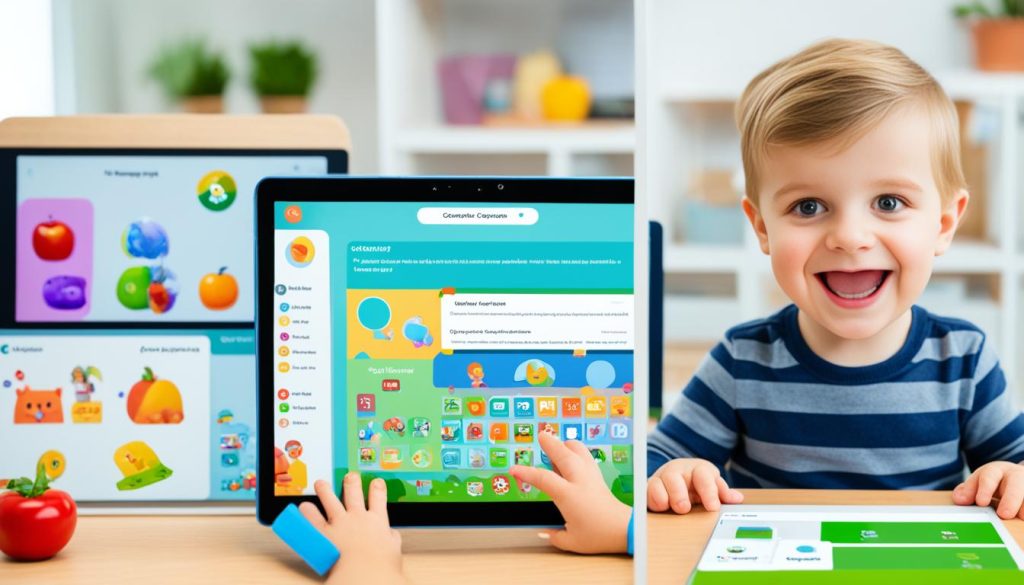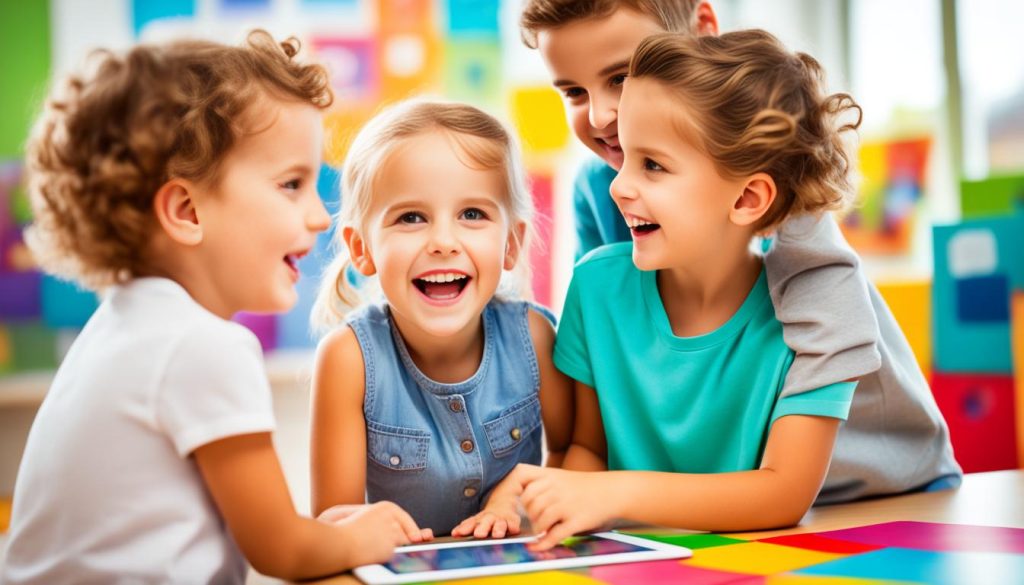The rise of technology has revolutionized the field of early education, opening up new opportunities for young learners. Online schools for early education, also known as virtual schools or online universities, have emerged as a flexible and convenient alternative to traditional learning environments. Distance learning for early education offers children the chance to develop essential skills and knowledge from the comfort of their own homes.
Accredited online schools for early education provide a structured curriculum that focuses on holistic child development. Through interactive lessons and engaging activities, these schools offer personalized learning experiences that cater to each child’s unique needs. The flexibility of online learning allows children to learn at their own pace, fostering a love for learning from an early age.
However, navigating the world of online schools for early education can be overwhelming for parents and educators alike. It is essential to understand the benefits and challenges of this educational approach to ensure a successful learning journey for young children.
Key Takeaways:
- Online schools for early education offer flexible and personalized learning experiences.
- Accredited online schools provide a structured curriculum for holistic child development.
- Distance learning allows children to learn at their own pace.
- Navigating online schools for early education requires understanding the benefits and challenges.
- Parents and educators play a crucial role in supporting children’s learning in online schools.
Understanding E-Schools and Their Place in Early Education
E-schools are revolutionizing the early education landscape, providing a flexible and personalized platform for young learners. These schools prioritize personalized learning, allowing children to engage with various types of content and maintain constant communication with teachers and peers. The goal is to create an interactive learning environment that fosters exploration, creation, and collaboration, equipping students with practical skills.
Amidst the shift towards e-schools, questions arise concerning the true engagement and overall impact on children’s learning and development. However, with the integration of technology, educators can tailor lessons to individual needs, promoting effective learning outcomes.
Enhancing Personalized Learning
In e-schools, personalized learning takes center stage, catering to each child’s unique abilities and interests. Through interactive platforms, students have access to diverse resources and multimedia materials that ignite their curiosity. They can explore different subjects at their own pace, enabling a deeper understanding of concepts and improved retention.
Promoting an Interactive Learning Environment
Interactive learning in e-schools fosters collaboration and critical thinking. Students can actively participate in discussions, problem-solving activities, and virtual experiments, enhancing their engagement with the curriculum. This interactive approach nurtures a love for learning and encourages the development of practical skills that are essential for future success.
“E-schools provide a dynamic and interactive learning environment, allowing children to actively engage with educational content and develop practical skills.”
Flexibility for Optimal Learning
E-schools offer flexibility in terms of scheduling and pace of learning. Students can optimize their learning experiences by organizing their study routines to align with their individual needs and preferences. This flexibility allows children to balance their educational commitments with other activities and interests, resulting in a well-rounded development.
Empowering Practical Skills
One of the key advantages of e-schools is their focus on equipping students with practical skills relevant to the modern world. Through interactive learning platforms, children can develop technological literacy, critical thinking, problem-solving, and digital communication skills. These practical skills are essential for their future academic and professional success.
In conclusion, e-schools provide a unique opportunity for young learners to navigate early education in a personalized and interactive manner. By embracing the e-school model, children can develop practical skills while benefiting from a flexible and engaging learning experience. However, continuous evaluation and optimization are essential to ensure the true effectiveness of e-schools in the early education landscape.
The Growth and Concerns of Online Learning in Early Years
Online early childhood programs have witnessed a significant surge in popularity, providing cost-effective alternatives for preschool education. These programs offer convenient access to quality education, enabling children to learn from the comfort of their homes. However, concerns persist regarding certain aspects of online learning that may impact the holistic development of young learners.
Academic Achievement
One of the primary concerns surrounding online early childhood programs is the potential impact on academic achievement. While these programs offer flexibility and personalized learning experiences, some critics argue that the absence of face-to-face interactions with teachers and peers may hinder academic progress. It is crucial to assess the effectiveness of online learning in promoting academic achievement among young children.
Long-Term Benefits
Another area of concern is the long-term benefits of online learning in early childhood education. Traditional preschool settings often focus on fostering social and emotional development, building interpersonal relationships, and encouraging hands-on activities. It is essential to evaluate whether online programs can provide similar opportunities for children to develop these essential skills.
Workforce Support
Online learning in early childhood education may pose challenges in terms of workforce support. Teachers play a crucial role in guiding and facilitating the learning process for young children. In online programs, the limited availability of teachers and the absence of direct supervision may raise concerns about the level of support children receive while navigating digital platforms.
Benefits and Limitations
To ensure a well-rounded understanding of online learning in early childhood education, it is important to critically analyze the benefits and limitations of these programs. The table below summarizes some key aspects to consider:
| Benefits | Limitations |
|---|---|
| Flexibility in learning schedules | Lack of in-person interactions |
| Personalized learning experiences | Potential impact on socio-emotional development |
| Access to a wide range of educational resources | Challenges in workforce support |
| Convenience and accessibility | Screen time management |
By critically evaluating these benefits and limitations, educators, parents, and policymakers can make informed decisions regarding the integration of online learning in early childhood education, ensuring a balanced and effective approach.

“The potential benefits of online learning in early childhood education should be weighed against the concerns surrounding interpersonal relationships, holistic development, and workforce support.” – Education expert
Supplemental Apps vs. Full Online Early Childhood Programs
When it comes to online early childhood education, parents have two main options: supplemental educational apps and full online preschool programs. Both formats offer unique benefits and considerations for young learners. Let’s explore the characteristics of each and how they can support your child’s education.
Supplemental Educational Apps
Supplemental educational apps are designed to complement traditional learning methods and provide engaging and interactive content. These apps offer a wide range of age-appropriate activities, games, and lessons that reinforce key concepts taught in school or at home. They can be accessed on various digital devices, such as smartphones and tablets, allowing children to learn anytime and anywhere.
One notable advantage of supplemental apps is their flexibility. Parents can choose specific apps that align with their child’s interests or areas of improvement. Whether it’s practicing math skills, learning new vocabulary, or exploring science concepts, there is an abundance of interactive content available. Supplemental apps can be highly engaging and capture children’s attention, making learning more enjoyable and memorable.
“Supplemental apps provide a wide range of engaging and interactive content that reinforces key concepts taught in school or at home.”
Additionally, these apps often provide progress tracking features, allowing parents to monitor their child’s learning and identify areas that may require additional support. This feedback loop enables personalized learning experiences and empowers parents to actively participate in their child’s education.
Full Online Preschool Programs
In contrast, full online preschool programs serve as a primary source of education and require parents to create a conducive learning environment at home. These comprehensive programs offer a complete curriculum that covers various subjects and developmental domains. They typically include interactive lessons, guided activities, and assessments to assess the child’s progress.
By enrolling in a full online preschool program, parents can provide their children with a structured and comprehensive educational experience. These programs often incorporate age-appropriate technology and interactive content to create an engaging learning environment. However, it is crucial to ensure that the digital tools used align with the child’s developmental stage to optimize their learning outcomes.
A full online preschool program offers the convenience of learning from home, eliminating the need for commuting or adhering to specific schedules. Parents can have greater control over their child’s education, allowing for flexibility in balancing other commitments, such as work or household responsibilities. It also promotes family involvement in the learning process, fostering a collaborative and supportive educational environment.
Choosing the Right Option
When deciding between supplemental educational apps and full online preschool programs, parents should consider their child’s individual needs, learning preferences, and overall goals. Some children may benefit from the targeted reinforcement provided by supplemental apps, while others may thrive in a structured online preschool program.
It is important to choose age-appropriate technology and ensure that the content provided is interactive and engaging. Consider the educational objectives, curriculum coverage, learning outcomes, and parental involvement required for each option. Evaluating reviews, seeking recommendations from educators, and exploring free trial offers can also help in making an informed decision.

| Supplemental Apps | Full Online Preschool Programs |
|---|---|
| Complement traditional learning methods | Serve as a primary source of education |
| Provide engaging and interactive content | Offer comprehensive curriculum coverage |
| Flexibility in selecting specific apps | Structured and guided learning experiences |
| Allow for personalized learning | Promote family involvement |
| Accessible on various digital devices | Leverage age-appropriate technology |
Remember, both supplemental apps and full online preschool programs can play valuable roles in your child’s educational journey. It’s important to evaluate your child’s needs, explore the available options, and choose the approach that best aligns with your family’s values and goals.
The Gamification of Learning and its Implications
The use of gamification in learning has gained popularity among young children, with games like Roblox providing engaging and interactive experiences. The concept of incorporating game elements into educational platforms has shown promising results, fostering a fun and monitored learning environment.
However, it is essential to consider certain factors to ensure the effective and appropriate use of gamification in early education. Age-appropriate games should be chosen to align with children’s developmental stages and educational goals. This selection process helps maintain a balance between entertainment and learning objectives, ensuring that the games facilitate skill development and knowledge acquisition.

Another aspect to consider is screen time management. While gamified learning can be highly engaging, it is crucial to establish healthy screen time limits to promote a balanced lifestyle. Parents and educators should monitor and guide children’s usage of online games, ensuring that they do not replace other important activities such as physical play, social interactions, and rest.
Online interactions within gamified learning environments also require careful oversight. It is essential to create a safe online space for children by emphasizing respectful and responsible behavior. Educators and parents should educate children about appropriate online conduct and encourage positive digital citizenship.
In addition to the immediate benefits of gamification in learning, incidental learning plays a critical role. While engaging in gameplay, children can unknowingly acquire various skills and knowledge beyond the primary educational objectives. This type of learning allows for flexibility and adaptability as children explore and experiment within the game environment.
The gamification of learning provides an opportunity for children to develop problem-solving skills, critical thinking abilities, and creativity while having fun. It enhances their motivation to learn and promotes independent learning experiences.
Capturing the potential of gamified learning requires a conscious effort to strike a balance between entertainment and educational value. By integrating age-appropriate games, managing screen time, fostering safe online interactions, and recognizing the power of incidental learning, we can harness the benefits of gamification in early education.
Ensuring Safety in E-Schools: A Checklist
Safety is paramount in e-schools, especially when it comes to the well-being of young children. Implementing a comprehensive checklist can help evaluate the safety measures in educational programs, ensuring a secure and protected learning environment. The checklist should consider the following factors:
1. Safe Interactions
Ensure that e-school platforms provide safe interactions for students. This includes features such as monitored chat rooms, filters to prevent inappropriate content, and clear guidelines for online behavior. It is important to foster a respectful and inclusive virtual community.
2. Data Privacy
Protecting student data is essential in e-schools. Verify that the online education platform has strict data privacy policies in place. This should include secure data storage, encryption measures, and adherence to relevant data protection regulations.
3. Monitoring Social Interactions
Regularly monitor social interactions within the e-school environment to identify and address any potential issues or concerns. Encourage open communication between students, parents, and teachers to promptly address and resolve any conflicts or incidents.
4. Data Breach Protocols
Ensure that the e-school has robust protocols in place to prevent and respond to data breaches. This includes conducting regular security audits, updating software and systems, and providing training to staff and students on data protection practices.
5. Parental Rights
Respect and uphold parental rights in e-schools. Provide parents with clear information regarding their rights, including access to their child’s academic progress and the ability to manage privacy settings. Encourage parental involvement in the online learning process.
6. Ethical Content Standards
Establish and enforce ethical content standards in e-schools. Ensure that educational materials are age-appropriate, inclusive, and respectful of diverse backgrounds and cultures. Regularly review and update content to maintain relevance and accuracy.
“Safety should be at the forefront of every e-school’s agenda. By implementing a comprehensive checklist, parents and educators can create a secure and nurturing learning environment for young children.”

Strategies for Successful Integration of Technology in Early Education
Technology has become an integral part of early education, offering a digital advantage that enhances learning experiences. To effectively integrate technology into the classroom, it is essential to embrace its advantages while addressing the challenges that arise. Here are some strategies to ensure successful integration:
1. Provide Interactive and Personalized Learning Experiences
Interactive learning engages young learners and promotes active participation. Utilize educational apps and software that encourage exploration, problem-solving, and creativity. Customized learning experiences tailored to individual needs and interests foster a sense of ownership and motivation.
2. Manage Screen Time
While technology provides valuable learning opportunities, it is crucial to manage screen time appropriately. Set clear guidelines and time limits to prevent excessive exposure to digital devices. Balancing screen time with other activities promotes a healthy and well-rounded early education experience.
3. Promote Digital Literacy Among Educators
Support educators in acquiring digital literacy skills to effectively utilize technology in the classroom. Provide training and resources that empower teachers to navigate digital platforms, integrate digital tools into lesson plans, and ensure digital safety for students.
4. Raise Awareness of Online Safety
Online safety is of utmost importance in the digital age. Educate students about safe online practices, including responsible internet use and the potential risks of sharing personal information. Implement protocols and tools to safeguard student data and privacy.
5. Select Age-Appropriate Technology
Choose technology tools and apps that align with the developmental stage of young learners. Age-appropriate content and features facilitate engagement, comprehension, and skill development. Regularly evaluate and update technology resources to meet evolving needs.
6. Encourage Collaborative Learning
Technology enables collaborative learning experiences, allowing students to work together on projects, share ideas, and build interpersonal skills. Foster a sense of community and cooperation through online discussion forums, virtual group activities, and peer-to-peer interactions.
7. Involve Parents in the Digital Learning Process
Parental involvement is crucial for successful technology integration. Educate parents about the benefits of technology in early education, provide resources for supporting digital literacy at home, and encourage open communication between parents, teachers, and students.
8. Regular Evaluation of Technology Integration
Continuously assess the effectiveness of technology integration in early education. Gather feedback from teachers, students, and parents to identify areas of improvement. Adapt and refine strategies based on the insights gained from evaluation.
By implementing these strategies, early education institutions can harness the power of technology to create a dynamic and engaging learning environment. With a balanced approach that prioritizes interactive and personalized learning, manages screen time, promotes digital literacy, ensures online safety, selects age-appropriate technology, encourages collaboration, and involves parents, the integration of technology in early education can unlock immense educational opportunities.

| Advantages of Technology Integration in Early Education | Challenges of Technology Integration in Early Education |
|---|---|
| Enhanced engagement and motivation | Risk of excessive screen time |
| Personalized learning experiences | Concerns about digital literacy among educators |
| Access to a wide range of educational resources | Online safety and privacy concerns |
| Development of 21st-century skills | Selection of age-appropriate technology |
| Collaborative learning opportunities | Ensuring parental involvement and support |
Conclusion
The rise of online schools for early education has brought about significant opportunities for the empowerment of young learners. These virtual learning platforms offer flexible learning options and personalized experiences, allowing children to explore and grow at their own pace.
However, it is important to navigate the challenges that come with online learning. Appropriate screen time management is crucial to ensure a healthy balance between online and offline activities. Educators also need to develop digital literacy skills to effectively engage with students in the digital realm.
Moreover, online safety should be a top priority for parents and educators. By implementing strategies for safe and responsible online interactions, we can create a secure and enriching learning environment for young minds.
By understanding the benefits of online learning and addressing the challenges, we can pave the way for the early education empowerment of our children. Online schools provide the tools and resources necessary to nurture their growth and development, allowing them to thrive in the digital age.
FAQ
What are the benefits of online schools for early education?
What are the concerns about online learning in early childhood?
What are the main formats for online early childhood education?
How can I ensure that the technology used in online early childhood education is age-appropriate?
Can gamification be incorporated into online early childhood education?
How can safety be ensured in online schools for early education?
What strategies can help successfully integrate technology in early education?
What are the benefits and challenges of online schools for early education?
Source Links
- https://ceinternational1892.org/article/e-schools-navigating-early-education-in-the-digital-age/
- https://www.youngacademics.com.au/empowering-young-minds-navigating-the-digital-landscape-in-early-education/
- https://www.nu.edu/degrees/teacher-education/programs/bachelor-of-arts-in-early-childhood-education/




No comments! Be the first commenter?